The stroke type occurs in those who have a deformity called a patent foramen ovale, an opening between two of the heart's chambers. While up to 30 percent of the general population has this condition, most are unaware they do. And long-term air travel boosts the risk of getting this type of stroke when the abnormality is present, the authors say.
While the link between air travel and blood clots in the lungs has been widely studied and publicized, a connection between flying and strokes has not been fully explored till now.
The new study, appearing in the June 24 issue of Neurology, may be the first to report on it, the researchers say.
But the study's co-author says the findings should not alarm most passengers.
"It's a real problem but a small one," says Dr. Stephen W. Borron, an associate clinical professor of emergency medicine and medicine at George Washington University School of Medicine in Washington, D.C.. "There are millions of passenger miles [logged] without any problems."
Borron and his colleagues from Avicenne Hospital in Bobigny, France, examined passengers arriving at Paris' Charles de Gaulle Airport over an eight-year period, from 1993 to 2000. Of the 155 million passengers, 65 were tended by a medical team for lung blood clots. And of those, four passengers, or 6 percent of those with lung blood clots, had strokes.
All four of those had the patent foramen ovale, the researchers say.
What happens, the researchers say, is that air travel can increase the risk of developing blood clots in the legs, which can then travel to the lungs and block an artery. Sometimes, the heart openings can allow the blood clot to enter the brain blood vessels and cause a stroke.
Putting the risk in perspective, Borron says, "Passengers traveling long distances, over 3,500 miles, appear to be at some increased risk, albeit small, of having a blood clot travel to the lungs. If they have patent foramen ovale, there is also a risk that the clot could travel to the brain. It must be emphasized that the number of people who have blood clots during air travel is low."
At greater risk, he says, is anyone who has had surgery within the previous month, those with cancer or previous blood clots, pregnant women, and anyone who has been immobile longer than three days.
"The results of this study are not surprising," says another expert, Dr. Cathy Helgason, director of the cerebrovascular service at the University of Illinois College of Medicine in Chicago.
Most people with the heart abnormality would not know they have it, Borron says, unless they have had an echocardiogram of the heart or cardiac catheterization.
Both Borron and Helgason advise passengers flying more than 3,500 miles to take precautions.
"Anyone traveling long distances should be aware of the findings of this study," Helgason says. "Frequent walks up and down aisle, exercise of the lower extremities and arms, as well as maintenance of good hydration under such circumstances, should play a role in prevention."
"If you are taking a long flight, make sure you get a little exercise on the plane," Borron agrees.
If you can't walk up and down the aisle, he adds, do in-seat exercises, moving your ankles to keep the blood flowing.
In an earlier study of lung blood clots, Borron found that 85 percent of those affected had not moved around during the lengthy flight.
More information
For more information on stroke risk factors, click on the National Institute of Neurological Disorders and Stroke or the American Heart Association.
Sunday, November 27, 2005
Wednesday, November 02, 2005
Women's Judo
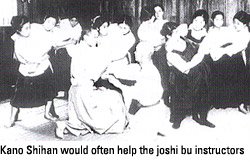
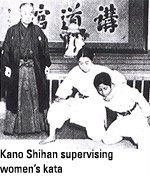
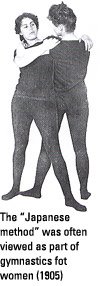
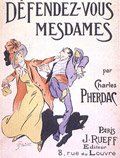
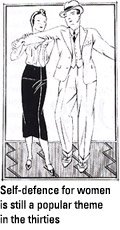
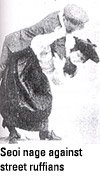
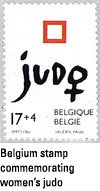
The feminine judo players who won the gold during judo contests at the Olympic Games in Atlanta received titles strictly equal to those of the men's division. Japanese Ryoko Tamura, French Marie-Claire Restoux, Israelian Yael Arad and others are so well-known in their own countries that their fame is no longer restricted to the judo world. Their rise to the highest levels is emblematic. But, it cannot overshadow the obstacles women had to overcome to make their own way and establish feminine practice in a world dominated by male-defined standards and values.
History tells us about the place occupied by women. It appears to obey two opposite models. Women's attitudes and behavior either seem to be dictated by masculine patterns, or reveal their strong opposition to their social status, their quest for recognition. Looking back at the position women had in the judo world, two different periods are obvious. From the beginning of the century to the sixties, women have played nothing more than a minor role. Apart from rare exceptions, their autonomy was drastically reduced. The design of a women's practice, distinctive from the men's, was overdetermined by gender differences and life styles. From the sixties onwards a shift occurred in the social attitudes expected from women. Modernised sport-oriented judo became a field for women who demanded equal rights and access to judo contests. The way judo permeated western countries and spread all over the world explains how feminine practice evolved and differed according to places and societies.
In the early days of the century, Japanese combat techniques became famous worldwide. The amazing victories of the Japanese army during hand-to-hand fights puzzled observers, men and women. The Japanese method rehabilitated the use of a fair force. It was thus bound to appeal to the "new woman" fighting for her rights in the early days of the century. However, very few were then involved in martial arts. Women's practice reveals sociability patterns. Their techniques were constrained by the rules of decorum. Physical contacts, proper clothing and respectable attitudes had to be adapted to class behavior. The way women could exercise was closely defined by medical experts who attempted to ban sporting activities which allegedly jeopardized female reproductive functions. Whereas professional manuals for soldiers or policemen displayed crude self-defense techniques, those written for women clearly mimed violence. The stress was put on health and physical exercise.
Still, although examples are rare, the emergence and the appeal of the Japanese method among women coincides with their struggle for autonomy. At the turn of the century, during the first wave of feminism, it was briefly used to fight the control of the dominant group in the struggle for suffrage. English suffragettes readily exploited the utilitarian side of jujutsu. They reportedly used jujutsu as a defensive weapon to fight policemen. The Japanese method was certainly seen as designed to pose a serious threat to the myth of female frailty. In 1912, prefacing, a French book entitled Defendez-vous Mesdames, the Countess of Abzac, begged modern women to acquire strength and freedom. She urged women to learn how to defend themselves. The appeal of the Japanese method among women was universal. The Fine Art of Jiu-Jitsu Emily Watts, from Great Britain, written in 1906, was prefaced by the Duchess of York. In the United States, Dennis Helm reports that, at the same time, Senator Lee's wife (grandson of General Robert E. Lee) and Mrs Wadsworth (relative of President Theodore Roosevelt) started to take judo lesson from Yoshiaki Yamashita. Many other examples can be given from Switzerland, Germany, Sweden.. The appeal of Japanese techniques of self-defense for women, no matter they are called jujutsu or judo, never flagged. They were quickly equated with autonomy and freedom.
In Japan, the art of fighting was a man's privilege. Here like elsewhere, physical education exercises for women were designed to make them healthy and improve their looks, to help them get ready for their future role of mothers. Many educators agreed : "Women are not meant to fight but to breed". Kano adopted the conception of the feminine body dictated by the scientific and medical theories of his time. The differences were biological. Kano did not want to overtax feminine bodies. He is said to have conferred with experts and judo medical science research personnel to make sure that the course of instruction and methods taught were right for women. "Develop one's mind and technique in harmony" was the motto of the women's section at the Kodokan. The stress was put on gentleness. The etiquette was strict. Ukemi was considered very important. Women were restricted in their randori. Any form of resistance was wrong. Kata practice was emphasized.
In the Kodokan archives, the first enrolment of women dates back to 1893. Miss Sueko Ashiya was recorded as the first girl to enter judo classes. Kano taught his wife, Sumako, and her personal friends. But, it is only in November 1926, that a women's section (joshi bu) was formally opened. The first woman to be awarded a black belt, in January 1933, was Katsuko Osaki. Noriko Watanuki,
Kano's eldest daughter was head of the women's section for many years.
Kano exerted every effort to internationalise his method. Traveling abroad, sending his leading disciples he organised the spread of judo. Slowly judo superseded jujutsu worldwide. With Kano's theories, the Japanese combat method acquired new scientific and educative dimensions. Women were also concerned by those changes but their practice was under the control of a teacher devoted to Japanese conceptions. In 1934, at Cherry Blossom as she says, Sarah Benedict Mayer arrived in Japan, staying until about April 1935. She was a member of the Budokwai of London and wrote a series of letters to her teacher, Gunji Koizumi, on her experiences. She met Kano and had lesons from Mifune. But, it was not before the late forties that women's judo started to become established and that women were gaining black belt status. After World War II, about 1949, Ruth Gardner from Chicago became the first non-Japanese female student to study at the Kodokan Institute in Tokyo, Marie-Rose Collet, from France, being the second. In Australia, in 1968, Patricia Harrington and Betty Huxley founded the first women's judo federation for the purpose of propagating Kodokan joshi judo. The Japanese example reinforced the beliefs of those who think strength is meant for men and aesthetics for women. Most of the time, women were taught by male instructors until some women became judo teachers. In California, Keiko Fukuda was instrumental in teaching a Kodokan-oriented women's judo. But, during the early sixties, Phyllis Harper voiced the leading conception of judo in the States. In an article entitled "Women's judo develops femininity", she affirmed : "Judo should be ladylike and should embody and exemplify the essence of the gentle way".
Because of the way Japanese hand-to-hand techniques are looked at, self-improvement through physical exercices and self-defense are the dynamos of the long interest women have had in judo. During World War II, elementary tricks were taught as "a basic escape training". In the relocation centers in the United States, women used to practice in order to keep fit and to be able to defend themselves. The evolution started in the sixties when women status in society changed and when judo began its shift into an international sport.
Rusty Kanokogi was the first female judo player to defy the rules of gender separatism. "I was considered an exceptional woman, a woman who played judo like a man". Pushing back her short hair, she entered the 1961 New York State YMCA championships. The world of judo, a traditionally male bastion, blatantly displayed its conservatism, the medal she won was taken away from her. The example of Rusty's judo career underscores the constraints currently imposed on women in the sixties, the prejudices of a male-dominated sport. Women had to fight for the right to fight. If, in the early fifties, female judoplayers were allowed to compete in some countries (France (1950), Morocco, then a French protectorate (1951)..), these isolated attempts were vain, and regularly ignored or laughed at. Up to then, women took part in grading contests but were denied the right to compete and obtain official titles. A new orientation appeared in the sixties in some European countries where tournaments were organized for female judo players (West Germany, Switzerland, Austria, then Italy, Great-Britai..). Judo as a sport no longer was a territory of virility to be conquered. On the contrary, female champions claimed equality as a right. Why should their participation be limited to technical tournaments or kata exhibitions? Female judo players of the seventies refused to be considered as a minority They demanded access to competitive meetings to be on an equal footing with men.
Mentalities evolved according to economic and social changes, but also with the number of medals obtained by women in international events, mostly when men's titles were harder to get. The rise of feminine judo reflects the general tendency and the debates of the seventies in favor of women's rights. It also reflects internal changes. The frame of reference was altered by the increasing sportive tendency. The International Olympic Committee's decision to include judo contests for men in the program of Tokyo's Olympics Games consequently allowed the definition of new finalities. Sport changed the scale of values and abilities. Progressively, the egalitarian perspectives of the coach replaced the gender-biased views of the judo master. To these internal evolutions must be added the effects of a consumer society which greatly influenced the motivation of judo players. The international culture of sport gradually replaced the Eastern culture of an educative martial art. Because of this growing tendency, the European Judo Union organised an experimental competition in 1974 in Genoa, Italy. The following year, in Munich, Germany, the first European judo championships for women took place. This decision and the first official titles awarded are all the more symbolic since in 1975 the year of women was celebrated. A similar evolution has been seen all over the world (first Oceanian women's in 1974, first Pan American women��s in 1976, first all Japan women's in 1978).
The first women's World Championships in New York in 1980, for which Rusty Kanokogi was largely responsible, and essentially the 1982 Paris Championships, radically erased the differences of the past. After the exhibition at Seoul, female judo has been part of the Olympics since the Games of Barcelona. In various countries, the number of members has significantly increased since female judo champions obtained World and Olympic titles. Statistics vary, but nowadays, women stand for roughly twenty percent of most color belts and about ten percent of black belts. Today, after Clare Hargrave from New Zealand, the first woman to be awarded the IJF "A" licence in 1981, there are female referees in both male and female international tournaments. In June 1998, in Berlin, Germany, 34 female referees from around the world joined the first ever seminar for women referees organized by the IJF.
Some female judo players have had their statues in Madame Tussaud's in London and in the Paris wax work museum, next to the best soccer players in the world. One century after Mrs Yasuda and her friends, the World and Olympic titles of Ingrid Berghams from Belgium, Cecile Nowak from France, Yamaguchi Kaori from Japan or Driulis Gonzales from Cuba underscore the equality of male and female judo players. This evolution was possible, mostly, because of pioneers who had the courage to fight traditions. It set up a chain reaction which compelled international judo to revise its models.
The place reached by women is linked to external and internal factors. The real causes of this evolution are numerous. Women's desire to have access to equal treatment, according with the policy to promote female victories and increase membership has challenged the cultural reluctance of certain countries. Women's participation is linked to the differences of finalism and values that distinguish a method of education from an international sport.
At six o'clock another contingent made an assault on shops in Regent Street, and fifteen minutes later Oxford Street was attacked. Mrs Garrud's jiu-jitsu school was just off Oxford Street in Argyle place and six of her Sufragette pupils were taking part in the stone throwing. [..]
Mrs Garrud's gymnasium was one of the bolt holes after the raid. She had taken up some of the floor-boards and covered over the gaps with heavy tatami mats. "They came back to the school because it was easy. They came straight in and turned those mats up. I made them strip off their outside clothes and give me their bags with their stones and any other missiles they had left over. All went under the floor-boards and back went the mats.
They were all in their jiu-jitsu coats working on the mats, when bang, bang, bang on the door. Six policemen ! I looked very thunderstuck and wanted to know what was the matter. "Well, can't we come in ?" said one of the policemen. I said : "No I'm sorry, but I've got six ladies here having a jiu-jitsu lesson. I don't expect gentlemen to come in here." He said : "Are they pupils ?" I said : "Yes, pupils." So, it ended up by one old man coming in and having a look round. He didn't see anything, only the girls busy working, and out he went again."
Antonia Raeburn, Militant Suffragettes, London, NEL, 1974.
I was born in 1871 and as I was weak in my youth I joined the dojo which was near our house. But, with the Russo-Japanese war I lost my teacher. Nethertheless, he had recommended to me a man named Kano Jigoro.[..] Afterwards, the Master taught me the yawara no kata (an old form of defense) and several defenses. After a month I began to study the falls and I repeated them for a month. Then, the following year, the Master suggested to me that we should climb Mont Fuji, the highest mountain in Japan, in order to judge our courage. We were five women and six men but, with one man, I was the only one to arrive in fairly good shape ; the others were fagged out. The next day, when I went to the dojo the Master invited me to practice and notwithstanding my protests on account of my fatigue, he bouted as strongly as usual. At the end, as he left me half dead with fatigue, he told me : "Take a bath and have some massage". This test proved to me that judo strenghtens woman both physically and morally.
On several occasions in my life I have saved people and myself thanks to judo. I have revived a carpenter fallen from a roof, left for dead by the doctor. I have saved one of my friends, almost drowned, and also left the same way. I have arrested an armed robber with my bare hands..
Kinko Yasuda, "Feminine judo", Judo, vol. V, n�� 1, January 1955
In a conversation with the late Prof. Jigoro Kano, he said to me, "I hope to spread women's judo throughout the world as widely as men's judo. Miss Fukuda, you must pursue the study of judo with this in mind". Naturally, those words of the founder of judo strongly impressed my young mind, and still remain vivid. Since then, I have endeavoured, in my own way to propagate women's judo. Perhaps, because of this effort, Prof. Kano often told men judoists, "If you really want to know true judo, take a look at the methods they use at the Kodokan joshi bu (women's section)". I am very proud of these words which have become a legend in the Kodokan. "Develop one's mind and technique in harmony" is taken as the motto of the women��s section, it is also important in men's training. [..]
The late Prof. Kano's ideal for women's judo was to study randori in parallel with kata. This randori must be done between women. I was instructed only in this manner for the first ten years of my judo study. Judoists in general spend many hours on randori. Although it is also true in women's judo, its characteristic is not to neglect kata while placing the importance on randori. This leads to the realistic methods of self-defense. This results in the increase of confidence in their everyday lives. Those who seriously study judo and master a higher degree of kata, may reach the point of acquiring "satori", comparable to that concept of "spiritual enlightment" in Zen Buddism, possessing a highly trained physique.
Keiko Fukuda, Born for the Mat, a Kodokan Kata Textbook for Women, 1973
Kano was taught jujutsu tenjin shin yo style from Keiko's grandfather Hachinosuke Fukuda. Keiko Fukuda and Masako Noritomi gave an exhibition of ju no kata during the Tokyo Olympics
It began in the fall of 1942 [..] A girl friend also was having a little figure trouble and when we discussed ways and means of doing something about our mutual problem, it suddenly occured to us that it might be smart to learn something about self-defense as well as to simply reduce [..]
About a year has passed since I first started at the Chicago Judo Club and in that time I had lost 35 pounds and was looking pretty good. The Club membership was dwindling fast. Most of our steady members had been either drafted or had volunteered into service. I took the fatal step myself and enlisted as an Air WAC [a member of the Women's Army Corps].
Later, in France I got my superior interested in judo. So, he approached the lieutenant who was in charge of special services and supplies. Alas, there were no mats. However, if we could get enough people interested in taking a course, perhaps they might be arranged. GI's, brass and even a French WAC caught on to the idea. About 10 women wanted to learn judo. A sour-faced sergeant summed it all up when he said, "We're fightin' a war. Military personnel are being bumped, but judo mats are being flown to you from England". The mats arrived and the classes began. The usual wholehearted enthusiasm was there on the part of all students, but only the most hardy and sincere stuck with it. We had classes split up so that I was teaching six nights a week. I could only teach what I knew, and soon came to the realization that a sankyu rating is not very high. However, my students were blissfully unaware of any shortcomings and the classes continued until our outfit began to move into Germany.
Ruth Gardner, "A Woman's-Eye View of Judo", in Robert W. Smith (edited by), A Complete Guide to Judo, Its Story and Practice, Rutland, Charles Tuttle, 1958.
At that time, applications didn't say "for men only", thought Rusty. She knew it was assumed that all players were male. She realized that her signature, "Rusty Glickman", wouldn't make anyone think otherwise. Pushing back her short hair and staying in the middle of her teammates, who wanted her with them and insisted that she had every right to be there? Rusty entered the gym and waited for her turn on the mat. When she stepped forward she thought she saw a few heads turn, but no one said anything. No one said anything when she won her match, either. But when she lined up with her team to get her medal, she was handed a note . The director wanted to see her.
"My teammates told me not to go", Rusty remembers. They said, "Stay in the line and get your medal and let him stew". But then it was a choice between being humiliated in public and being humiliated in private. I chose privacy, so I stepped off the line.
The director was furious.
"It wasn't an athletic thing with him", Rusty says. "It wasn't that he didn't think I could do it? obviously I could ! He didn't think women should. A woman just had no place there ?and he couldn't understand how I could have thought they did."
The former Coney Island Apache did not try to defend herself. She was afraid of being expelled from the class she was in at Brooklyn Central.
"It didn't say male on the application", she apologized. "If it had, I wouldn��t have entered."
After that, applications from the Y Association and the AAU had the word "male" on them, and Rusty was barred from competing.
Linda Atkinson, Women in the Martial Arts, Dodd, Mead &Co., New York, 1983.
90 year old Keiko Fukuda, the martial art's highest-ranked women, still goes to the mat for her Bay Area students.
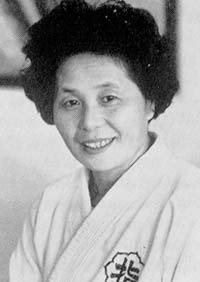
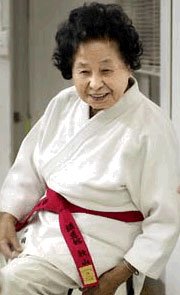

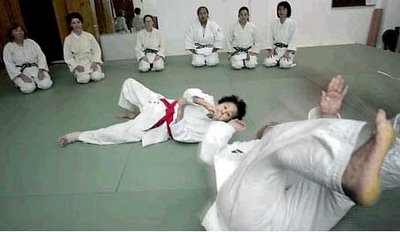
An elderly woman sits in the only chair allowed on the light green carpet of padded mats in the judo club. It's just a metal folding chair, but her students treat her like a queen on a throne. They hang on every soft-spoken word, every wave of a hand, every approving nod or smile.
She is dressed in brilliant white: a quilted jacket with overlapping lapels over thin white pants with reinforced knees. It is her cherry-red belt, knotted loosely over her jacket, that marks her as sovereign. The belt signifies that Keiko Fukuda, who celebrated her 90th birthday last spring, is the highest-ranking woman in the world in judo, a Japanese martial art in which technique and balance -- rather than power -- are the key to victory.
During a recent class in her San Francisco club, Fukuda watched a 22-year-old woman struggling to learn a new move -- a "side sacrifice" technique, in which the attacker drops to the ground while grasping the lapels of an opponent's uniform, rolls to one side and tosses the opponent into a heels-over-head somersault to the mat.
In judo, an individual uses an opponent's strength, weight and momentum against the opponent. When words and gestures failed to get an important point across, Fukuda rose slowly to her feet. She left her sturdy black cane, with its wide curving crook, resting on the mat. In tiny, staggered steps, Fukuda moved into position in front of the student. She reached up to grab the young woman's lapels, grasping them with wrinkled hands stiff from arthritis and weakened from old judo injuries. The room fell silent. Everyone else stopped training and turned to watch. Fukuda dropped, rolled and threw her young opponent -- three times in a row. She then returned to her chair for the rest of the two-hour class.
"There are times when she'll do that, get up and show us something, but not too often," said student Molly Boutdy, who was learning the technique for a coming test for a higher ranking. "She can't stand up for long." Fukuda, who speaks English with a strong accent, can be hard to understand at times. But that doesn't hinder communication with her students. "She gets her point across," 57-year-old Vaughn Imada said with a fond laugh. Imada, who runs the San Jose Buddhist Judo Club, travels to San Francisco once a month to take Fukuda's advanced class. Imada, who has been studying judo for 30 years, said Fukuda sometimes uses sounds, instead of words, to convey a concept. "We listen to those sounds -- and we laugh," Imada said. "Then we think about it. Then we try the technique again and say: Oh, that's what you meant." He said Fukuda is a strict, but patient, teacher. "She makes judo fun," Imada said. "Everyone enjoys learning from her."
Keiko Fukuda
Vicki Trent, now the highest-ranking student in Fukuda's club, spent 16 years driving back and forth from her home in Santa Cruz to the club in San Francisco. Finally, 11 years ago, Trent moved to the city to be close to the school and to the woman who had become her mentor. Trent, a 48-year-old attorney who recently became a real estate agent, said the word "enlightened" comes to mind when she thinks about Fukuda, who teaches the philosophy of judo, as well as its physical techniques. "She is a person like everybody else -- with foibles. I've certainly seen that over the years. At the same time, her awareness of the truth and the deeper meaning of life is evident in her sense of humor and her love of life, in her joie de vivre," Trent said. "That has kept me quite devoted to her as a teacher."
Keiko Fukuda Fukuda, who stands a couple inches shy of 5 feet, has been teaching judo for nearly 70 years. Fukuda, who surrendered her Japanese citizenship to become a U.S. citizen, has traveled all over her adopted country spreading the gospel of judo. She also has given seminars in Australia, Canada, New Zealand, Norway and the Philippines. When she was 76, she flew to France to teach the country's top-ranked judo instructors. The U.S. Judo Federation, which represents more than 350 clubs, gave Fukuda the red belt in 2001, in recognition of her lifelong contributions -- domestic and international -- to the martial art. The U.S. federation has awarded only three red belts. The two other recipients were men, who have since died. The belt indicates Fukuda has reached the ninth dan level in judo. In the history of the 120-year-old martial art, only about a dozen people in the world have achieved a higher rank -- the 10th level. She continues teaching today despite the ailments of old age -- Parkinson's Disease, which makes her right hand tremble like a leaf in a breeze, triple bypass surgery more than a decade ago, and aged ankles and knees.
"Her spirit and mind are carrying her through," said Shelley Fernandez, 72, a former student who invited Fukuda to live in her Noe Valley home when Fukuda landed a job teaching judo at Mills College in Oakland. Fernandez thought she might stay a year or two. That was 37 years ago. "My mother died in 1965, and Keiko came to live with me in 1966," Fernandez recalled. "It was like my mother came back to me. Keiko has the same personality as my mother -- a joyousness about life and a warmth for people. She was God's gift to me."
Fukuda is revered as one of the last living disciples of Jigoro Kano, the founder of judo. Kano, who opened his judo school -- known as the Kodokan -- in Tokyo in 1882, added a "Women's Section" about 40 years later. When Fukuda began taking lessons in 1935, she was one of only two-dozen women in the school, which is known today as the Kodokan International Judo Center. Kano had invited her to study judo because of her martial art lineage. She was the granddaughter of a renowned jujitsu master, who had taught that Japanese martial art to Kano. "At that time, I was only 21 years old, being taught the ways of Flower Arranging, Formal Tea Ceremony and Brush Writing, which was customary for young ladies in Japanese society," Fukuda wrote in her 1973 book, "Born for the Mat: A Kodokan Kata Textbook for Women." Through memories of my grandfather I felt very close to judo, even though I had never seen judo practiced before." Fukuda's mother -- her father died when Fukuda was very young -- accompanied her to the judo school that day. "I decided to take Judo lessons a few months later," Fukuda wrote. "My mother and brother both supported me, although my uncle opposed the idea because I was a woman. My mother's and my brother's thoughts were for me to learn, and get married to a Judoka (a judo expert) someday, but not to become a Judoka myself." She would never marry.
"Judo is my lifetime partner," Fukuda said, speaking through a translator during a recent interview in her Noe Valley home. "Any place I go, judo is my family. Students are very nice to me. I have family all over the world.'' Fukuda first visited the United States at the invitation of a judo club in Oakland in 1953. She stayed for almost 2 years. She returned to California in 1966 and traveled all over the state giving seminars. That same year, she gave a judo demonstration at Mills College, and the school immediately offered her a job. She taught judo there for more than a decade.
During those same years, Fukuda also taught in the home she shared with Fernandez on Hoffman Street. When the number of students swelled, she moved her classes to a Buddhist temple in Japantown. Her club, the Soko Joshi Judo Club ("The Women's Judo Club"), moved to its current quarters, at Castro and 26th streets, in 1973.
Fukuda still teaches there three days a week, offering classes for female students aged 13 and older. Her students have hailed from all over the Bay Area, including San Rafael, Berkeley, San Jose, San Francisco and Santa Cruz. The wall above the wooden desk in the club is crowded with more than a dozen plaques from grateful students. Most begin with the words "In Appreciation." Many more awards are stashed in her home just a few blocks away. She has given her "Order of the Sacred Treasure, Gold Rays with Rosette," a silver-and-gold medal studded with dots of ruby-red ceramic, to her brother's family in Japan. The award is one of the country's most prestigious honors for people aged 70 and older. The Consul General of Japan gave Fukuda the medal, along with a signed certificate from the Prime Minister of Japan, at a gala dinner in San Francisco in 1990.
Last week, Fukuda took home another award -- an engraved silver bowl from Tiffany. She was one of four women over age 70 who received 2003 Women of Achievement, Vision and Excellence awards from GirlSource, a nonprofit group for low-income teenagers in San Francisco. "Too many awards, too many awards," Fukuda quietly insists. Fukuda's judo motto is: "Be strong, be gentle, be beautiful." For those unfamiliar with judo, it may be hard to reconcile the words "gentle" and "beautiful" with a sport in which competitors send opponents sailing through the air and slamming to the ground.
Fukuda said the goal of judo is to be "gentle on the outside" and "strong on the inside." In "Born for the Mat," she described training in Tokyo under a renowned judo master, Kyuzo Mifune. "I remember clearly to this day that his grip on my Judo uniform was so gentle that I was not aware of it,'' she wrote. "Still, if I made the slightest movement in an attempt to throw him, he was no longer in that position; instead, my body would be flying through the air. Professor Mifune was small, even for a Japanese man (about 5 feet 3 inches), but his body movements were extremely speedy and it was very difficult to keep up with him, because he could foresee the opponent's movements and could forestall him ahead of time."
Fukuda is renowned for her expertise in judo "kata,'' a choreographed, mock fight between two people that demonstrates, in various combinations, the martial art's offensive and defensive moves. "Through the study of Kata, one will experience the true spirit of actual fighting, and comprehend the principles of technique," she wrote in "Born for the Mat" which includes step-by-step instructions, in words and photographs, of the seven katas of judo.
Fukuda's second book will be released this spring by North Atlantic Books in Berkeley. The book, titled "Ju No Kata,'' focuses on a slow-motion, elegant kata whose mastery is required to enter the higher ranks of judo. "She is a living treasure from another era,'' said Jess O'Brien, the publisher's martial arts editor. "Her influence on judo is widespread. She has been training so long and she is still able to find new insights into Ju No Kata -- obvious ones and subtle ones.''
The book's cover photograph shows Fukuda performing a particularly difficult move, in which she is balanced on a partner's arched back. Fukuda's body tilts at a 45-degree angle to the floor, her head facing the mat, her toes pointing toward the ceiling -- a move she had to hold for several seconds. A black-and-white photograph hanging in Fukuda's home shows her -- at 51 -- in that same gravity-defying pose, during a kata demonstration at the 1964 Summer Olympics in Tokyo.
Keiko Fukuda - 1954 demonstration with Helen Carollo
Keiko Fukuda, then a 5th dan, demonstrating Ippon Seoinage with Helen Carollo in a 1954 demonstration in Fresno, California. She came to the US after teaching at the Kodokan for 14 years to help promote Judo to American women.
It was the first year in which men earned Olympic medals in freestyle judo, matches in which competitors won points for throws and immobilizing holds. Women's freestyle matches were added at the 1992 Olympics in Barcelona. But there is no kata competition at the international event -- a situation Fukuda would like to change.
Fifteen years ago, she established her own tournament, the Fukuda Judo Kata Championships. This year, the tournament will be held on Oct. 25 at the San Jose Buddhist Judo Club. It is expected to attract about 100 participants, including competitors from other countries. Fukuda has also worked for many years to spread kata competitions throughout the world, said Robert Fukuda (no relation), executive director of the U.S. Judo Federation.
"What she's trying to do is get kata competition included as part of the world championships," he said. "Then the opportunity opens up for it to become part of the Olympics. Part of her work over the years has been to get kata competitions more diffused around the world. More of the unions (there are five unions in the International Judo Federation) are doing it. The Pan American Judo Union is the only one that has an official kata championship."
While Fukuda's sights are set on that Herculean goal, she has no problem focusing her still-keen eyes on the parade of students who still seek her advice and appraisal. When she attends judo seminars these days, Fukuda usually watches students from the protective comfort of a wheelchair. But she doesn't hesitate to rise out of the chair onto the mat when she sees they need help.
"It's almost like someone has hooked her up to a battery charger," Robert Fukuda said. "She comes out of the wheelchair, gets out there, demonstrates the technique and sits back down. You can see that it takes a lot out of her. But that's just how she is. She wants to help. She wants people to do it correctly. To learn the right way."
"Be strong, be gentle, be beautiful."
Motto of Keiko Fukuda, kudan
Tuesday, November 01, 2005
Tea for Immunity
This is a small (11 subjects), short-term (2-4 weeks), pilot study that appears in a peer-reviewed journal. It adds a small piece to the body of scientific literature that suggests that drinking tea may be beneficial to health. In the Nutrition Logic: Food First, Supplements Second book tea is discussed on pages 69-70.
Tea for Immunity
By Kathleen Doheny
HealthScoutNews Reporter
MONDAY, April 21 (HealthScoutNews) -- Drinking tea may help "prime" your immune system and enable you to fight off bacterial infections better, a new study suggests.
The research, appearing in the April 21-25 issue of the Proceedings of the National Academy of Sciences, adds to the growing list of health benefits researchers have attributed to tea. Previous research has found that the drink can help ward off heart disease and cancer, probably due to its abundance of antioxidants.
The infection-fighting ability of tea, however, is attributed to a substance found in some tea,
called L-theanine, which is broken down into a group of chemicals called alkylamine antigens. Antigens are substances that produce antibodies to fight infections.
The new research studied the effects of these antigens on gamma-delta T cells, one of the
immune system's infection fighters.
The study was small, cautions the lead author, Dr. Jack Bukowski, an assistant professor of medicine at Harvard Medical School (news - web sites) and staff rheumatologist at Brigham and Women's Hospital in Boston. And while his team proved that tea drinkers, compared to coffee drinkers, had more ability to produce disease-fighting chemicals, the researchers did not track whether the tea drinkers actually experienced fewer infections.
Even so, Bukowski says, "there's no downside to drinking tea. I heartily recommend drinking tea."
His team first did work in the laboratory, exposing some cultured human gamma-delta T cells to an alkylamine antigen but not exposing others. Then they exposed the cells to bacteria, simulating an infection. The cells exposed to the antigen produced much interferon, an infection-fighter, in the first 24 hours, Bukowski says, while those not exposed did not produce it.
"The gamma delta T cells were responsible," he says. The study also proved that these cells have a memory, he says, and are able to recognize bacteria the next time and fight them.
Next, Bukowski and his team asked 11 subjects to drink five to six cups of black tea every day, and another 10 people to drink the same quantity of instant coffee. The subjects did this for either two or four weeks.
Then, two weeks into the study, the researchers tested the blood of coffee and tea drinkers by exposing it to bacteria in the lab and comparing samples taken before the study to those taken two weeks later. "We found they [tea drinkers] made five times more interferon after they started drinking tea compared to before drinking tea," Bukowski says. The coffee drinkers showed no enhanced production of interferon.
Not all teas contain L-theanine, Bukowski cautions. Green, black, oolong, or pekoe teas do, he says.
Coffee drinkers might consider cutting down on coffee, he says, and adding tea -- hot or iced --to their daily intake of beverage.
If the research bears out, tea drinking may prove to offer protection from skin infections caused by bacteria, bacterial pneumonias, and food poisoning, among other ailments, Bukowski says.
Another expert who has researched tea and its antioxidant benefits says the study results make sense.
"These compounds may prime our immune cells so that when they see [bacteria] they are better able to respond," says Jeffrey B. Blumberg. He is a professor and chief of the Antioxidants Research Laboratory and senior scientist at the Jean Mayer USDA Human Nutrition Research Center on Aging in Boston.
"I'm really impressed," Blumberg says of the study's findings. "The responses [in the tea drinkers] were very marked." Blumberg notes, however, that the study was a pilot study, with details such as age of the subjects not available, and that more research is needed.
Still, he adds, "It's a fascinating study."
Besides being present in tea, the alkylamine antigens are found in lower concentrations in apples and mushrooms as well as red and white wine, Bukowski says.
Tea for Immunity
By Kathleen Doheny
HealthScoutNews Reporter
MONDAY, April 21 (HealthScoutNews) -- Drinking tea may help "prime" your immune system and enable you to fight off bacterial infections better, a new study suggests.
The research, appearing in the April 21-25 issue of the Proceedings of the National Academy of Sciences, adds to the growing list of health benefits researchers have attributed to tea. Previous research has found that the drink can help ward off heart disease and cancer, probably due to its abundance of antioxidants.
The infection-fighting ability of tea, however, is attributed to a substance found in some tea,
called L-theanine, which is broken down into a group of chemicals called alkylamine antigens. Antigens are substances that produce antibodies to fight infections.
The new research studied the effects of these antigens on gamma-delta T cells, one of the
immune system's infection fighters.
The study was small, cautions the lead author, Dr. Jack Bukowski, an assistant professor of medicine at Harvard Medical School (news - web sites) and staff rheumatologist at Brigham and Women's Hospital in Boston. And while his team proved that tea drinkers, compared to coffee drinkers, had more ability to produce disease-fighting chemicals, the researchers did not track whether the tea drinkers actually experienced fewer infections.
Even so, Bukowski says, "there's no downside to drinking tea. I heartily recommend drinking tea."
His team first did work in the laboratory, exposing some cultured human gamma-delta T cells to an alkylamine antigen but not exposing others. Then they exposed the cells to bacteria, simulating an infection. The cells exposed to the antigen produced much interferon, an infection-fighter, in the first 24 hours, Bukowski says, while those not exposed did not produce it.
"The gamma delta T cells were responsible," he says. The study also proved that these cells have a memory, he says, and are able to recognize bacteria the next time and fight them.
Next, Bukowski and his team asked 11 subjects to drink five to six cups of black tea every day, and another 10 people to drink the same quantity of instant coffee. The subjects did this for either two or four weeks.
Then, two weeks into the study, the researchers tested the blood of coffee and tea drinkers by exposing it to bacteria in the lab and comparing samples taken before the study to those taken two weeks later. "We found they [tea drinkers] made five times more interferon after they started drinking tea compared to before drinking tea," Bukowski says. The coffee drinkers showed no enhanced production of interferon.
Not all teas contain L-theanine, Bukowski cautions. Green, black, oolong, or pekoe teas do, he says.
Coffee drinkers might consider cutting down on coffee, he says, and adding tea -- hot or iced --to their daily intake of beverage.
If the research bears out, tea drinking may prove to offer protection from skin infections caused by bacteria, bacterial pneumonias, and food poisoning, among other ailments, Bukowski says.
Another expert who has researched tea and its antioxidant benefits says the study results make sense.
"These compounds may prime our immune cells so that when they see [bacteria] they are better able to respond," says Jeffrey B. Blumberg. He is a professor and chief of the Antioxidants Research Laboratory and senior scientist at the Jean Mayer USDA Human Nutrition Research Center on Aging in Boston.
"I'm really impressed," Blumberg says of the study's findings. "The responses [in the tea drinkers] were very marked." Blumberg notes, however, that the study was a pilot study, with details such as age of the subjects not available, and that more research is needed.
Still, he adds, "It's a fascinating study."
Besides being present in tea, the alkylamine antigens are found in lower concentrations in apples and mushrooms as well as red and white wine, Bukowski says.
Too Many Vitamin Pills Can Be Bad for You: Study
Comment:
The following news story out of London notes that most supplements are safe but that many common and frequently used vitamin and mineral supplements have the potential to cause harm. The entire report can be found at http://www.food.gov.uk. This is the website of the Food Standards Agency (FSA), an independent food safety watchdog set up by the British Parliament to “protect the public’s health and consumer interests in relation to food.” The Nutrition Logic: Food First, Supplements Second book devotes nearly 60 pages to these issues.
Too Many Vitamin Pills Can Be Bad for You: Study
LONDON (Reuters) - Some vitamin and mineral supplements can be bad for you if you take too many for too long, Britain's food watchdog cautioned Thursday.
Most supplements are safe, the Food Standards (news - web sites) Agency (FSA) said. But in new advice for the public, the agency said high levels of the supplement chromium picolinate may cause cancer, and identified other common vitamins and minerals whose long-term use could be dangerous.
Three other common supplements -- vitamin C, calcium and iron -- may have harmful effects in large doses even over short periods, although the symptoms from these disappear if the supplements are no longer taken.
'While in most cases you can get all the nutrients you need from a balanced diet, many people choose to take supplements. But taking some high-dose supplements over a long period of time could be harmful,' Sir John Krebs, the chairman of the agency, said in a statement. The FSA said more than 1,000 milligrams (mg) per day of vitamin C, 1,500 mg per day of calcium or 17 mg of iron can cause abdominal pain and diarrhea in some people, although the symptoms disappear after the supplements are no longer taken.
The agency advised against taking more than 10 mg of vitamin B6 daily unless under medical care. Beta-carotene, an antioxidant found in orange and yellow fruits and vegetables, could cause irreversible harmful effects in smokers if taken long-term and in high doses, it said.
Manganese could be dangerous for older people over an extended period of time, the agency said, while nicotinic acid, zinc and phosphorous could also be harmful in high doses over the long term.
The advice, which is listed on the FSA's Web site (www.food.gov.uk), is based on an
independent expert review of the scientific evidence on the safety of vitamins and minerals. It is designed to help consumers make informed choices.
'In addition, the Board of the Food Standards Agency will be considering what further action we would wish the supplements industry to take,' Krebs added.
The FSA reviewed 34 vitamins and minerals with particular emphasis on long-term use.
It suggests that 10 mg a day or less of chromium in forms other than chromium picolinate is safe. The agency said it is also consulting on a proposal to ban chromium picolinate, which is sometimes promoted as being helpful in evening out blood sugar levels, in the manufacture of food supplements.
The following news story out of London notes that most supplements are safe but that many common and frequently used vitamin and mineral supplements have the potential to cause harm. The entire report can be found at http://www.food.gov.uk. This is the website of the Food Standards Agency (FSA), an independent food safety watchdog set up by the British Parliament to “protect the public’s health and consumer interests in relation to food.” The Nutrition Logic: Food First, Supplements Second book devotes nearly 60 pages to these issues.
Too Many Vitamin Pills Can Be Bad for You: Study
LONDON (Reuters) - Some vitamin and mineral supplements can be bad for you if you take too many for too long, Britain's food watchdog cautioned Thursday.
Most supplements are safe, the Food Standards (news - web sites) Agency (FSA) said. But in new advice for the public, the agency said high levels of the supplement chromium picolinate may cause cancer, and identified other common vitamins and minerals whose long-term use could be dangerous.
Three other common supplements -- vitamin C, calcium and iron -- may have harmful effects in large doses even over short periods, although the symptoms from these disappear if the supplements are no longer taken.
'While in most cases you can get all the nutrients you need from a balanced diet, many people choose to take supplements. But taking some high-dose supplements over a long period of time could be harmful,' Sir John Krebs, the chairman of the agency, said in a statement. The FSA said more than 1,000 milligrams (mg) per day of vitamin C, 1,500 mg per day of calcium or 17 mg of iron can cause abdominal pain and diarrhea in some people, although the symptoms disappear after the supplements are no longer taken.
The agency advised against taking more than 10 mg of vitamin B6 daily unless under medical care. Beta-carotene, an antioxidant found in orange and yellow fruits and vegetables, could cause irreversible harmful effects in smokers if taken long-term and in high doses, it said.
Manganese could be dangerous for older people over an extended period of time, the agency said, while nicotinic acid, zinc and phosphorous could also be harmful in high doses over the long term.
The advice, which is listed on the FSA's Web site (www.food.gov.uk), is based on an
independent expert review of the scientific evidence on the safety of vitamins and minerals. It is designed to help consumers make informed choices.
'In addition, the Board of the Food Standards Agency will be considering what further action we would wish the supplements industry to take,' Krebs added.
The FSA reviewed 34 vitamins and minerals with particular emphasis on long-term use.
It suggests that 10 mg a day or less of chromium in forms other than chromium picolinate is safe. The agency said it is also consulting on a proposal to ban chromium picolinate, which is sometimes promoted as being helpful in evening out blood sugar levels, in the manufacture of food supplements.
Requires Trans Fat to be Listed on the Label
Comment:
The FDA has announced a change to the Nutrition Facts label, the first label change since 1993. The new rule requires manufacturers to list the amount of trans fat on a separate line, which will appear directly below saturated fat on the label. Trans fat is a result of food processing and tends to raise blood cholesterol levels. Trans fat is formed when oils are processed into harder fats such as margarine or shortening. Processed foods containing trans fat include french fries, donuts, cookies, candies, crackers, baked goods and most snack-type foods. Trans fat has no known health benefits and its consumption should be as low as possible.
Information about trans fat is found on page 54 of Nutrition Logic: Food First, Supplements Second. To keep consumption of trans fat as low as possible choose heart healthy fats such as fish, nuts, seeds, and vegetable oils.
Excellent information, in a question and answer format, can be found at the FDA website, http://www.cfsan.fda.gov/~dms/qatrans2.html#s3q5
The FDA has announced a change to the Nutrition Facts label, the first label change since 1993. The new rule requires manufacturers to list the amount of trans fat on a separate line, which will appear directly below saturated fat on the label. Trans fat is a result of food processing and tends to raise blood cholesterol levels. Trans fat is formed when oils are processed into harder fats such as margarine or shortening. Processed foods containing trans fat include french fries, donuts, cookies, candies, crackers, baked goods and most snack-type foods. Trans fat has no known health benefits and its consumption should be as low as possible.
Information about trans fat is found on page 54 of Nutrition Logic: Food First, Supplements Second. To keep consumption of trans fat as low as possible choose heart healthy fats such as fish, nuts, seeds, and vegetable oils.
Excellent information, in a question and answer format, can be found at the FDA website, http://www.cfsan.fda.gov/~dms/qatrans2.html#s3q5
Whole Grains May Lower Risk of Diabetes
The February 2004 issue of Diabetes Care reports the results of a study that suggests the consumption of three or more servings of whole grains daily may reduce the risk of developing type 2 diabetes. Adults who consumed whole grains, especially fiber-rich cereals, had a lower risk of insulin resistance. Insulin resistance is one factor associated with the development of metabolic syndrome, and consequently, type 2 diabetes. It is estimated that one-fourth of the adult population have metabolic syndrome and the number of people with type 2 diabetes is rising.
Information about whole grains can be found in Nutrition Logic: Food First, Supplements Second on pages 17-21. It is important to look for certain terms on the labels, as the terms wheat and whole wheat are not the same (the latter is a whole grain). The average American consumes less than one serving of whole grains daily while nutritionists recommend the consumption of three servings each day. Nutrition Logic shows how to incorporate fiber-rich whole grains into the diet.
Information about whole grains can be found in Nutrition Logic: Food First, Supplements Second on pages 17-21. It is important to look for certain terms on the labels, as the terms wheat and whole wheat are not the same (the latter is a whole grain). The average American consumes less than one serving of whole grains daily while nutritionists recommend the consumption of three servings each day. Nutrition Logic shows how to incorporate fiber-rich whole grains into the diet.
Amount of “junk food” Americans consume stuns UC Berkeley researcher
Gladys Block, a UC Berkeley researcher, analyzed diets of almost 5,000 adults. She was not surprised that Americans eat junk food but she was surprised by the amount consumed. According to her research, which was published in the June issue of the Journal of Food Composition and Analysis, nearly one-third of all calories consumed were junk foods—soft drinks, sugared fruit-flavored drinks, alcohol, sweets, desserts, and salty snacks. She is quoted in the ContraCosta Times newspaper as saying, “Naturally we’re obese if we’re getting a third of our calories from these things. The part that I am more alarmed about than obesity is the empty-calorie issue.”
Comment:
While obesity may get all the media attention, dietitians and other health professionals have become increasingly worried about the lack of nutrients provided by many high calorie foods. These foods have been called “junk foods” or “empty-calorie foods” because they provide few vitamins, minerals or fiber and relatively high levels of calories. They are often high in sugar, fat and/or salt. Here’s a reality check from page 95 of Nutrition Logic: Food First, Supplements Second:
“If you want to have a healthy diet, many foods in the grocery store are not everyday foods; they are occasional foods. Occasionally you will want cake, cookies, and candy. Occasionally you will want chips, dip, and soft drinks. Occasionally you’ll want ice cream with chocolate syrup….If you have cake on your birthday but at few other times throughout the year, then it is an occasional food. The everyday foods keep you healthy, and the occasional foods are an added treat….Physically active people often comment that exercise allows them to eat more of the occasional foods and still keep their weight in balance.”
Comment:
While obesity may get all the media attention, dietitians and other health professionals have become increasingly worried about the lack of nutrients provided by many high calorie foods. These foods have been called “junk foods” or “empty-calorie foods” because they provide few vitamins, minerals or fiber and relatively high levels of calories. They are often high in sugar, fat and/or salt. Here’s a reality check from page 95 of Nutrition Logic: Food First, Supplements Second:
“If you want to have a healthy diet, many foods in the grocery store are not everyday foods; they are occasional foods. Occasionally you will want cake, cookies, and candy. Occasionally you will want chips, dip, and soft drinks. Occasionally you’ll want ice cream with chocolate syrup….If you have cake on your birthday but at few other times throughout the year, then it is an occasional food. The everyday foods keep you healthy, and the occasional foods are an added treat….Physically active people often comment that exercise allows them to eat more of the occasional foods and still keep their weight in balance.”
Subscribe to:
Comments (Atom)
Blog Archive
-
▼
2005
(45)
-
▼
November
(8)
- A long airplane flight can increase the risk of ha...
- Women's Judo
- 90 year old Keiko Fukuda, the martial art's highes...
- Tea for Immunity
- Too Many Vitamin Pills Can Be Bad for You: Study
- Requires Trans Fat to be Listed on the Label
- Whole Grains May Lower Risk of Diabetes
- Amount of “junk food” Americans consume stuns UC B...
-
▼
November
(8)